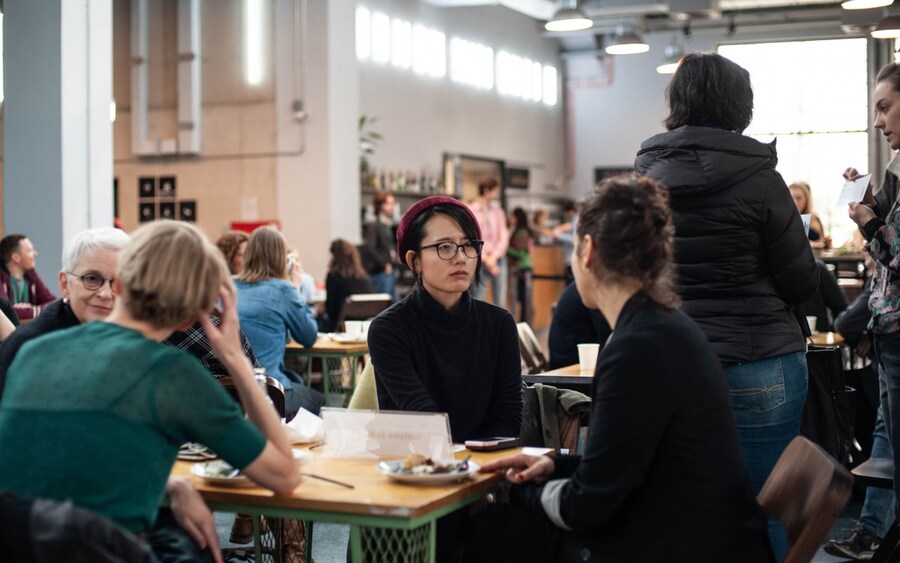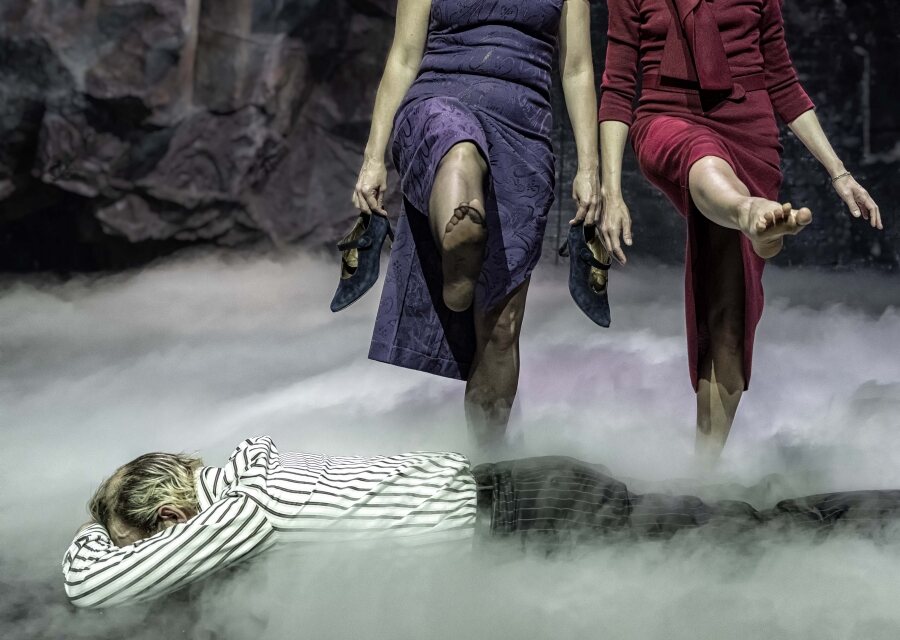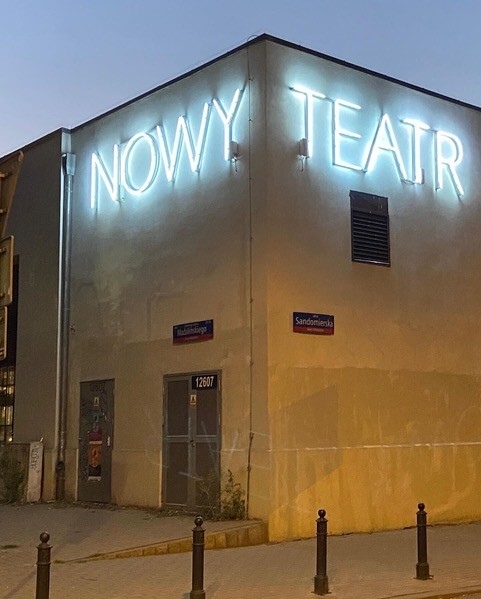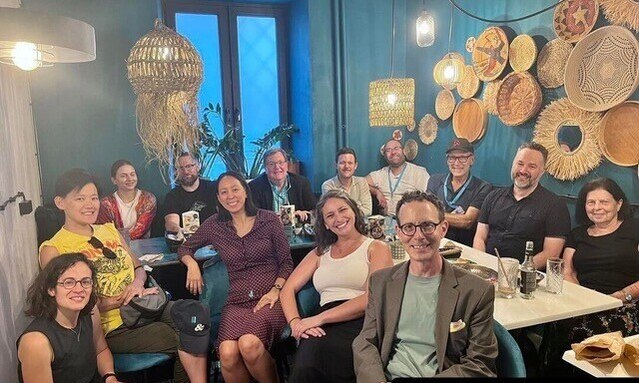Members of Theater Mitu, our Brooklyn-based company, traveled to Warsaw in early September, a full day before the Generation After Festival was set to begin. Upon landing, we saw a city of 1.7 million people basking in a brilliant sun—and we were fantastically jetlagged. The clarity and sparkle of the light was filtered through the lush greenery and vibrant energy of contemporary Warsaw.
We went for a long walk after checking into the hotel, which helped with the jetlag and amplified our sense of excitement. This was our first research trip since the pandemic. For decades, Mitu has been committed to expanding the definition of theatre, while seeking new innovations in arts practice. We do this through research trips, meeting artists and engaging with their work.
Our first stop on this trip: Pinball Station, an interactive museum dedicated to the time-honored game, tucked away in an old train station behind a tall apartment complex. It’s stocked with more than 100 unique pinball machines and arcade games dating back to 1932, though most machines are from the ’80s and ’90s, so that winning shots might trigger a Kiss song, and add-a-ball might send a Metallica riff zinging across the former train terminal.
It was a perfect place to ward off sleep and prime us for the festival to come. Much like a pinball game, the Generation After Festival would prove to be a journey to the very edge of how we might survive before the ball goes down the drain. But rather than forecast the game-ending tragedy of a lost ball, the festival would provide a glimpse into a country very much keeping the ball in play by valuing theatre as a space of dialogue and exchange, and recognizing its transformational power.
Our mission on the ground in Warsaw was to attend the Generation After Festival as members of the LINKAGES: Poland delegation, a boundary-expanding project of Philip Arnoult’s Center for International Theatre Development (CITD). Our hosts, Howard Shalwitz and Brandice Thompson, had invited us to document the trip, while accompanying their group of artists from the U.S. As participants in LINKAGES: Poland, the U.S. group was paired with contemporary Polish theatre artists. This cohort had spent the better part of two years in meetings over Zoom, and this would be the first time they would meet in person. The LINKAGES group from the U.S. included Abigail Browde + Michael Silverstone of 600 Highwaymen; director, performer, and translator Aya Ogawa; Ben Raanan, artistic director of Phamaly Theater; playwright, lyricist, and librettist Melisa Tien; Katie Yohe, artistic director of A.B.L.E. Ensemble; Ben Pesner, from the Venturous Theatre Fund; and Blair Ruble, a trustee of Trust For Mutual Understanding.
We happened to enter Poland on the cusp of a national election, which would see the conservative Law and Justice party lose its majority in parliament after an eight-year rule. The theme of the Generation After Festival, organized by Nowy Teatr, was “Reality Check: have we become so accustomed to our reality, we forget we can question it?” In 14 productions across four days, our pinball ride through Generation After would confront us with questions central to Poland’s relationship with abortion rights, queer identities, male emotions, and what family life is like living with a disability.
Day one began with a performance of JaWa by Janek Turkowski and Iwona Nowacka at Komuna Warszawa. Part art installation, part theatre piece, and part documentary performance lecture, the show disguised its complex dramaturgy as a simple slide show, outlining a year-long project involving the engagement of homeless men in the reconstruction and repurposing of outdoor spaces. But it proved to be a moving and intimate look at the social power of mixing art with the reality of addiction.
From there we walked to the National Museum of Warsaw to take in Ramona Nagabczyńska’s Bliss, a physicalized conversation between Witkacy’s “Treatise on Being in and for itself,” which considers corporeal reality, and Nagabczyńska’s own experience giving birth. A stunning movement piece of immediacy and humor performed on the steps of the museum’s foyer, the work depicted the joy of birth and blended ancient myths with contemporary horror films.
From there we were shot over to the Nowy Teatr for a production of The Metamorphosis by Grzegorz Jaremko, from Kafka’s novel, with text and dramaturgy by Mateusz Górniak. It retold the story of Gregor Samsa through the lens of a post-apocalyptic society, using live cinema to follow his transformation into the ”horrible vermin” we all must become to survive late-stage capitalism.

The Nowy Teatr’s physical space impressed us at first sight: part café, part bookstore, and part fully modernized theatre complex, the building itself is a space of gathering and community around food, books, art, and ideas. It reminded us of our home in Brooklyn, MITU580, where Theater Mitu gathers to make our work, and helped us dream of future spaces that are at once expansive and intimate, where our community might gather over coffee to discuss art and ideas.
For day two, we headed back to Nowy Teatr in the morning for Michał Zadara’s Institute for Performative Law lecture titled, “Who poisoned the Oder River?” It followed an investigation into local and national corruption launched by Zadara and his team after pollution killed millions of fish in a remote area of the title river. Next was Anna Karpenko’s lecture “In a Void: Performative Arts in Belarus,” which spoke to the history, bravery, and resistance of performative artists who continue to endure an “endless era of oppression” in the country.
A heady walk from the Nowy Teatr lobby dropped us in a nearby neighborhood basketball court for a performance of John Cage’s 122 Words on Music and Dance by Marta Ziółek and guests. An exercise in paying “attention to what it is, just as it is,” this piece involved six dancers, a drummer, and a saxophonist (with some serious circular breathing skills), all physically articulating and responding to Cage’s text. The effect was an “art in the everyday” experience, turning the audience, the passing pedestrians, and Warsaw traffic into dance partners.
From here, we shot up north to the Dramatyczny Theatre in central Warsaw for a performance of Michał Buszewicz’s Boys Cry. Tackling the emotions of men in a communal context, the piece depicts the toxicity of male emotional repression in modern society through compelling first-person testimony.
A brief tram ride across the Vistula River to the Praga neighborhood and the Powszechny Theatre would be our last stop of the day, to see Melodrama by Anna Smolar. An epic entanglement of the addicted and the co-dependent, Smolar’s live cinema feed disrupted our view of violence, betrayal, anger, and depression to reveal new insights into the “savior role” and what we must do to free ourselves from toxic relationships. In a post-show conversation, Smolar related that she likes “to use video as a tool to show how we manipulate the images. In Melodrama, we use it to get closer to the emotion and to build intimacy, and to show things that get lost on the bigger stage.”
Her detailed deconstruction of intimate relationships was an add-a-ball shot that gave us the energy for the next day’s program. Day three’s pinball drop began at the Museum of Modern Art for a day full of a wide range of original work. First up was the gallery exhibition and live performance of Kissing Doesn’t Kill: Ania Nowak and Guests. This exhibit centered queer grief over the loss of rights, health, and loved ones, through video, photography, sound art, painting, sculpture, and a performance action by Nowak. Guests were invited to wander the gallery. Nowak then appeared in the doorway and proceeded to charm, seduce, and encourage the audience to follow her as she engaged with the artworks on display. At once humorous, joyful, and moving, her performance and the exhibit honored the Gran Fury collective, a U.S. activist group that used the power of art to bring attention to the HIV/AIDS epidemic in New York City in the ’80s and ’90s.
From here we returned to the Nowy Theatr for Gosia Wdowik’s She Was a Friend of Someone Else. This technology-forward piece used AI photo manipulation, video design, and an ingenious fog effect to depict the limited access women have to reproductive health. Woven with personal narrative, profiles of women who came forward to publicly acknowledge their abortions, and an extraordinary physical performance from a silent and limp Wdowik, She Was a Friend gave voice to the communal outrage of Poland’s recent ban on abortion.
After a swift tram ride up to TR Warszawa, we arrived for their co-production with Theatre 21 of Family by Justyna Sobczyk. Structured like a TV sitcom and based on improvisations with Theatre 21’s company of actors with Down Syndrome and TR Warsawa’s company of non-disabled actors, the show had actors shift roles, each taking a turn playing mother-father-sister-brother-boyfriend-or-neighbor to poignant effect.
The final show of the evening was The Employees by Łukasz Twarkowski at the STUDIO Teatrgaleria. This AI origin story was a technological feat of live cinema and visual subterfuge. The audience moved freely around a four-sided transparent cube with huge video screens projecting the live cinema feeds of the action inside the box on every side. The production’s mastery of technology appealed to Mitu’s visual and performative aesthetic, while its use of live cinema as both a mirror and a portal through which to view opposing views of what our future might be beyond Earth made for an impactful spectacle.
Day four: We rose early to board a bus for a day trip to Krakow to view The Art of Living by Katarzyna Kalwat at the Narodowy Stary Teatr. An epic day and an all-too-brief visit to one of Poland’s most beloved and beautiful cities, The Art of Living was a five-hour attempt to distill George Perec’s epic novel Life as a user’s manual into a theatre event. It brought with it the uncomfortable knock of reality—a reaffirmation that life is both nomadic and solitary, while reminding us how essential connection, community, and co-existence are in our current moment.
On the late bus ride home, as the countryside unfolded into the darkness, we were finally able to begin processing the multiple realities we had witnessed over the last four days. Pinballing from one discipline to another, the festival twisted and turned us around, linking similar themes and viewpoints while inviting us to commune with theatregoers of all ages. At each performance, we witnessed groups of eager young people taking part in one of Poland’s greatest assets: a theatre where issues and topics are tackled with immediacy, innovation, and a real sense that multiple realities can exist around us all at once.
There was a memorable moment in the lobby of the the STUDIO Teatrgaleria when the LINKAGES: Poland cohort gathered with their Polish counterparts for brunch. It was as if the future of theatremaking in the U.S. was colliding with the future of Polish theatre in one room. The excitement and energy of this room was one jackpot we racked up from this festival’s pinball game. And it was a testament to the work of LINKAGES: Poland and the Center for International Theatre Development.
It has been two months since Mitu members returned to Brooklyn, but the Generation After Festival is still with us. In our fridge at MITU580, we now stock tonic water and lemon to produce a constant stream of tonic espressos—the drink that fueled us through the festival. And Mitu has been busy developing a new project and supporting our Van Lier Fellows as they participate in our performance and technology fellowship, the Hybrid Arts Lab. We returned from Poland especially excited by the range of engagements with technology we witnessed, particularly live cinema and its influence on narrative, emotion, how humans gaze, and how this all shapes our daily sociopolitical interactions.
Above all, we left Warsaw hopeful that the vibrant conversations this art form can produce is alive and well. As Mitu opened the doors of MITU580 to share our Hybrid Arts Lab fellows and samples of their work this November, we witnessed a full house of young folks willing to jump into a conversation about innovative artmaking, the power of small arts spaces, and the resources these spaces can provide to early-career and emerging artists. To see these future makers and audience members fill up MITU580 this fall reminded us of Warsaw, and of that jackpot gathering of artists in the STUDIO Teatrgaleria.
It’s clear that there will be generational change in the theatre. The next cohort of makers is already playing that pinball game, all over the world, and there is a curious community hungry for the add-a-ball extra life music to play.
Denis Butkus (he/him) and Justin Nestor (he/him) are company members of Theater Mitu. Together they work with founding artistic director Rubén Polendo and an interdisciplinary group of company members to expand the definition of theatre through methodical experimentation with the form.








